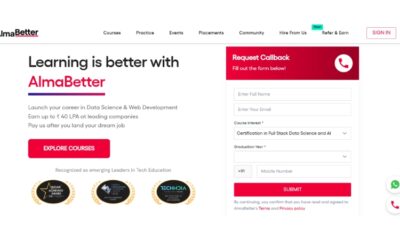Business
Effective Strategies for Engaging Students in Higher Education by Francis Sullivan

Student engagement is not just a buzzword but a fundamental aspect of practical education. Engaged students actively participate in their learning journey, taking ownership of their education and maximizing their potential. They are more motivated, attentive, and invested in their coursework, resulting in improved academic performance. But the benefits of student engagement extend beyond grades and test scores.
As a Chief Operating Officer, Francis Sullivan understands the importance of nurturing talent, fostering creativity, and developing a culture of continuous learning. However, the significance of student engagement in higher education extends far beyond the classroom walls. It plays a crucial role in shaping the future workforce, fueling innovation, and driving societal progress.
The Significance of Student Engagement in Higher Education
Student engagement plays a pivotal role in shaping the success and reputation of higher education institutions. Engaged students are more likely to persist, graduate, and achieve better academic results. According to a study by the Association of American Colleges and Universities, actively engaged students are twice as likely to report being academically and personally satisfied than their less engaged peers. Moreover, engaged students contribute to a vibrant and dynamic campus community, fostering a positive learning environment for everyone.
Understanding the Challenges
While student engagement is vital, several challenges hinder its implementation. Although a powerful tool for engagement, technology can also be a double-edged sword. It is crucial to balance incorporating technology and preserving meaningful face-to-face interactions. Students’ diverse backgrounds and learning styles also pose challenges for designing inclusive and engaging strategies that cater to individual needs.
Effective Strategies for Engaging Students in Higher Education
Engaging students in higher education is crucial for their academic success, personal development, and the overall growth of educational institutions. Implementing effective strategies to enhance student engagement fosters a dynamic learning environment and empowers students to participate actively in their education. Here are some key strategies that can be employed
Interactive and Experiential Learning
Incorporating interactive and experiential learning approaches stimulates student engagement. Group projects, simulations, and field trips provide hands-on experiences, collaboration, and critical thinking opportunities, allowing students to apply their knowledge in practical contexts.
Utilizing Technology
Technology offers numerous possibilities for engaging students in higher education. Tools like online discussion boards, virtual reality simulations, and gamified learning platforms can enhance interactivity, promote collaboration, and provide personalized learning experiences.
Active Learning Techniques
Active learning shifts the focus from passive listening to active participation. Flipped classrooms, case studies, and discussions encourage students to analyze and apply concepts actively. These techniques foster critical thinking, problem-solving, and communication skills.
Personalization and Customization
Tailoring educational experiences to individual students’ needs can significantly boost engagement. Adaptive learning platforms, personalized feedback, and flexible assignments empower students to take ownership of their learning, making the educational journey more relevant and meaningful.
Building a Supportive Learning Environment
A positive and inclusive learning environment nurtures engagement. Promoting strong student-staff relationships, peer-to-peer collaboration, and creating safe spaces for open dialogue fosters a sense of belonging and encourages active participation.
Overcoming Barriers and Implementing Effective Strategies
Implementing effective student engagement strategies in higher education can face barriers such as resistance to change, limited resources, and inadequate time. Overcoming these barriers requires fostering a culture of collaboration, starting small and scaling up, providing professional development opportunities, and supporting innovative approaches.
Ongoing evaluation and feedback are crucial for improving engagement initiatives. Collecting and analyzing data, seeking student feedback, and promoting faculty reflection and collaboration help refine strategies to meet evolving student needs.
By addressing barriers and implementing effective strategies, institutions can create an environment conducive to student engagement, ultimately enhancing student learning experience and outcomes.
Conclusion
Engaging students in higher education is paramount for their success and the overall growth of educational institutions. By implementing effective strategies such as interactive and experiential learning, leveraging technology, adopting active learning techniques, personalizing educational experiences, and fostering supportive learning environments, institutions can create an environment that motivates students to become active participants in their learning journey. Francis Sullivan considers the importance of student engagement, and these strategies can also be applied to foster innovation and growth within his organization. Institutions and industries can cultivate a culture of continuous learning, collaboration, and success by prioritizing student engagement.
-

 Sports4 weeks ago
Sports4 weeks agoAl Ahly vs Inter Miami, 2025 FIFA Club World Cup – Preview, Prediction, Predicted Lineups and How to Watch
-
Health3 weeks ago
Back to Roots: Ayurveda Offers Natural Cure for Common Hair Woes
-

 Tech3 weeks ago
Tech3 weeks agoFrom Soil to Silicon: The Rise of Agriculture AI and Drone Innovations in 2025
-

 Startup4 weeks ago
Startup4 weeks agoHow Instagram Is Driving Global Social Media Marketing Trends
-

 Sports3 weeks ago
Sports3 weeks agoFIBA 3×3 World Cup 2025: Full Schedule, Preview, and How to Watch
-

 Science4 days ago
Science4 days agoJuly Full Moon 2025: Everything You Should Need to Know, When and Where to See Buck Moon
-

 Gadget3 weeks ago
Gadget3 weeks agoThings to Know about Samsung Galaxy S26: What’s New and What’s Next
-

 Sports4 weeks ago
Sports4 weeks agoWorld Judo Championships 2025: Full Schedule, Date, Time, Key Athletes and How to Watch

























